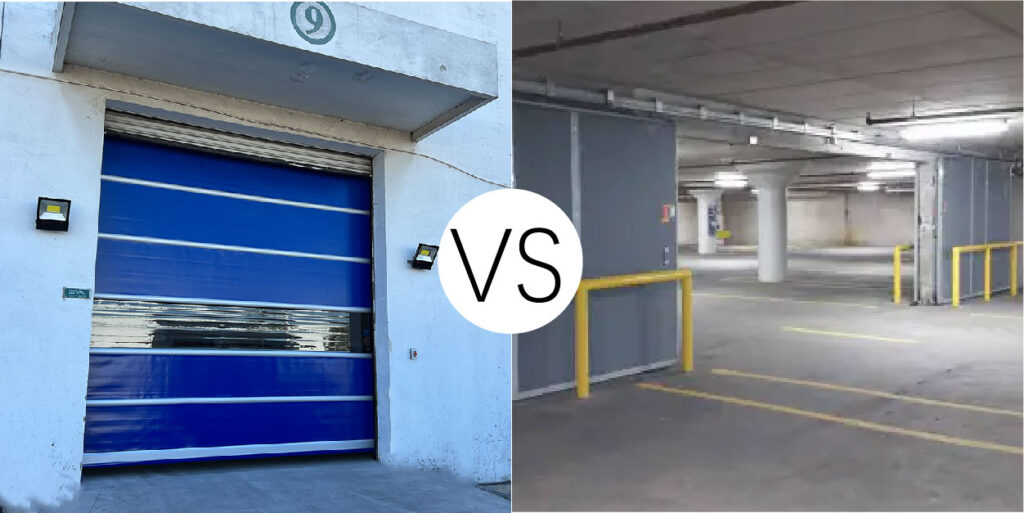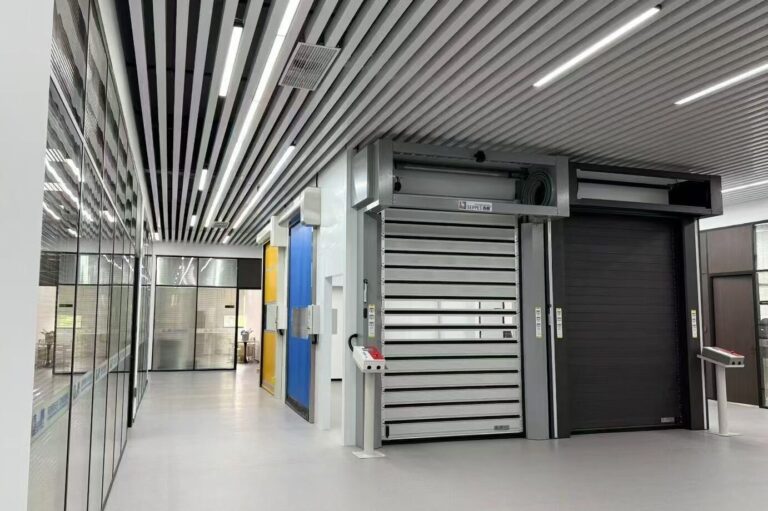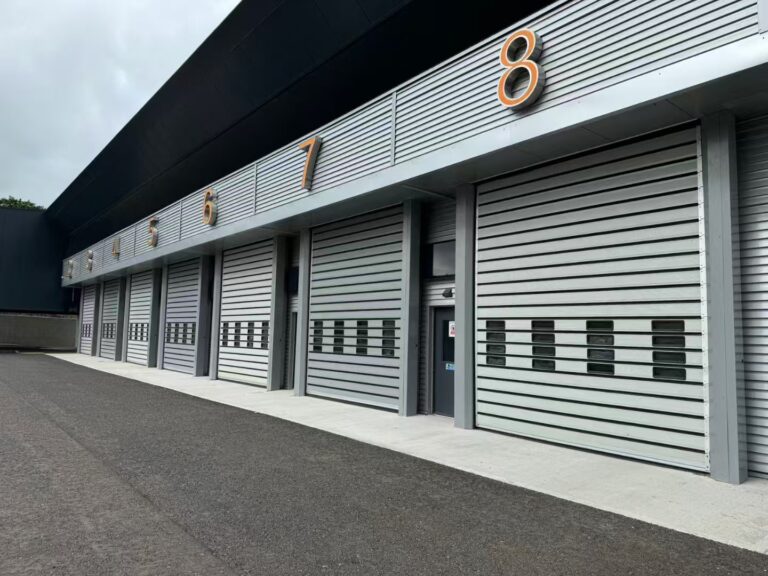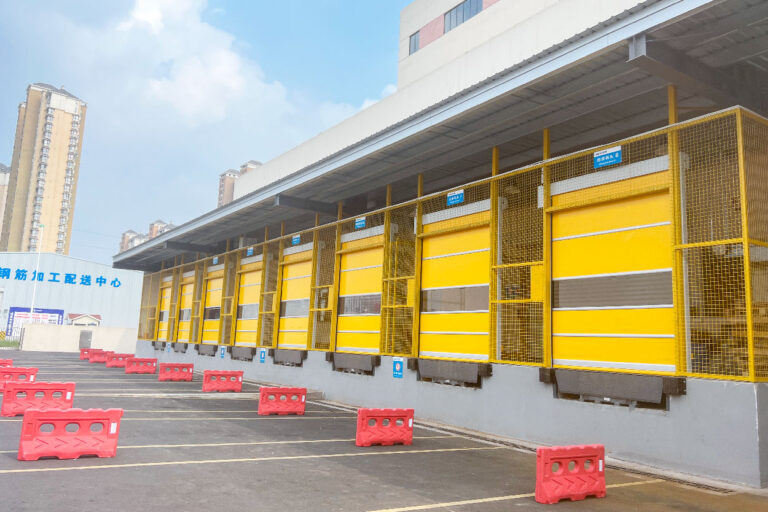What is an Interior Roll Up Door?
An interior roll-up door is a rapid roll-up door system specifically designed for internal areas, such as industrial buildings, warehouses, logistics facilities, and clean rooms. It is primarily used for zone management, temperature and humidity control, dust isolation, and high-frequency passage of personnel and equipment.
It typically consists of a flexible PVC curtain and aluminum alloy tracks, driven by a motor to achieve rapid opening and closing. This system effectively enhances operational efficiency and environmental control capabilities, serving as a high-performance alternative to traditional swing doors or sliding doors in industrial internal partitioning applications.
Typical application scenarios
Logistics channels between workshops and warehouses
Cold and warm zone partitions (such as normal temperature zones and refrigerated zones)
Internal isolation of clean spaces for food, electronics, medical care, etc.
Safe passage control in areas where personnel and forklifts frequently mix
- commerce sorting centers, SMT workshops, packaging/clean zone connection points
Core Advantages of Interior Roll-Up Doors

Efficient Passage and Energy-Saving Control
Opening speed is generally 0.8–1.5 m/s, significantly reducing door opening time, lowering energy consumption, and minimizing temperature and humidity exchange.
Excellent Sealing and Isolation Performance
Equipped with fully enclosed EPDM sealing strips on the upper and lower sides, effectively isolating dust, odors, pressure fluctuations, or pollution sources.
Comprehensive Safety Protection Features
Standard features include infrared photoelectric protection and bottom safety airbags to prevent the door from pinching people or equipment during descent.
Compact Structure with Strong Adaptability
Utilizes top-mounted motor drive and track-mounted installation, occupying no space on either side of the passageway, making it suitable for most indoor structural environments.
Real-life case study: Internal partitioning in an electronics workshop
Project background
Project location: An electronics manufacturing company in Jiangsu Province
Application scenario: Material passageway between the SMT workshop and the raw materials warehouse
Customer requirements:
High-frequency traffic (>300 times/day)
Maintain cleanliness and temperature stability
Enable automatic forklift sensing and passage
Reduce the risk of dust cross-contamination
configuration plan
| Project Item | Configuration Details |
| Door Size | W2500mm × H2800mm |
| Door Curtain Material | Blue 0.9mm high-density flame-retardant PVC |
| Drive System | Industrial-grade high-speed motor + inverter control |
| Control Method | Dual-side radar sensor + button switch |
| Safety Configuration | Photoelectric protection + soft bottom edge airbag |
| Sealing Design | EPDM sealing strip around the perimeter |
Feedback on use
Passage efficiency improved by approximately 35%, with smooth and uninterrupted movement of personnel and forklifts.
Temperature difference control ±2℃, meeting process requirements.
Stable door curtain opening and closing, no stuttering, low failure rate.
Reduced internal dust, meeting ISO Class 8 cleanliness standards.
Operators report a good user experience and high degree of automation.
Comparison and analysis with traditional door types

| Comparison items | Interior Roll Up Door | Traditional swing doors/sliding doors |
| Opening and closing speed | 0.8–1.5 m/s | Usually <0.2 m/s |
| Space utilization | Takes up space at the top, saving passage width | Occupies door leaf opening angle space |
| Adaptability to opening and closing frequency | ≥500 times/day | <100 times/day (frequent use causes wear and tear) |
| Sealing performance | High (fully sealed design on all sides) | Medium to low (air and dust leakage at edges) |
| Level of automation | Supports multiple smart controls | Mostly manual or basic electric control |
Interior Roll Up Door Selection Recommendations
| Evaluation dimensions | Recommended configuration |
| Opening and closing frequency | For high-frequency use, we recommend selecting a servo motor + variable frequency drive control. |
| Spatial layout | We recommend a clearance of ≥600 mm at the top and ≥150 mm on both sides. |
| Passage objects | For areas where people and vehicles share the same space, we recommend using a combination of radar and photoelectric sensors. |
| Cleanliness level | We recommend using anti-static PVC curtains + a positive pressure environment sealing structure. |
| Budget control | You can choose basic radar control or reserve an interface for later upgrades. |
Maintenance and usage precautions
Monthly: Check for wear on the door curtain, debris in the track, and the response speed of the photoelectric system.
Quarterly: Maintain the control box, lubricate the motor, and tighten the screws.
Semi-annually: Check the tension of the door curtain, wear on the guide rail, and the function of the safety airbag.
Recommendation: Install a UPS power failure emergency opening system to ensure manual operation during emergencies.
FAQ (Concise Version)
Q1: Is the installation of an interior roll-up door complicated?
Installation is relatively straightforward, requiring only the mounting of tracks and motors at the top. The process can be completed in 1–2 days.
Q2: Can it be integrated with an access control system?
Yes. The PLC system is compatible with RFID, barcode scanners, facial recognition systems, and more.
Q3: Can this door be customized with different colors or windows?
Yes. Users can choose PVC curtain fabric in multiple colors and add transparent windows or brand logos as needed.





